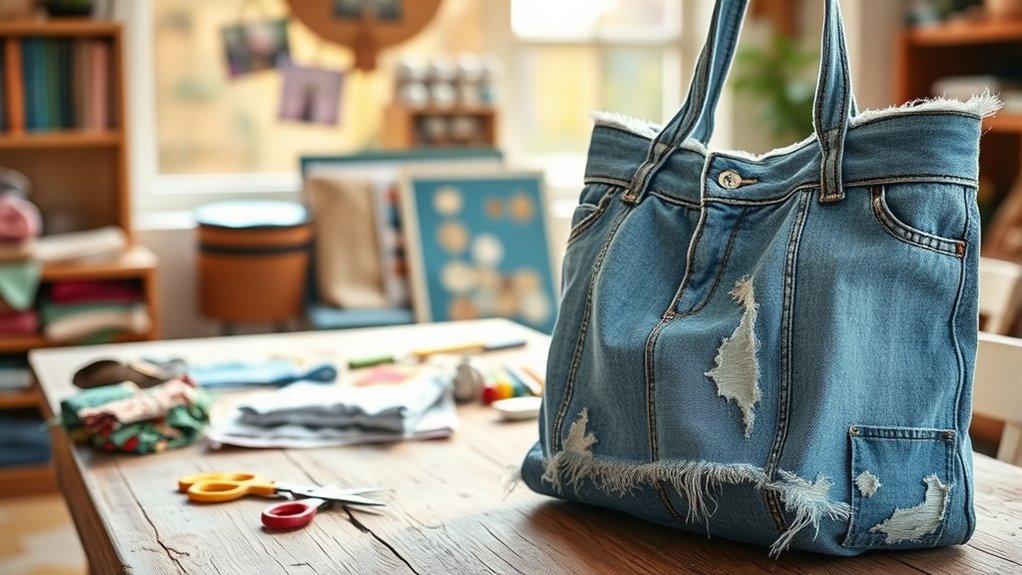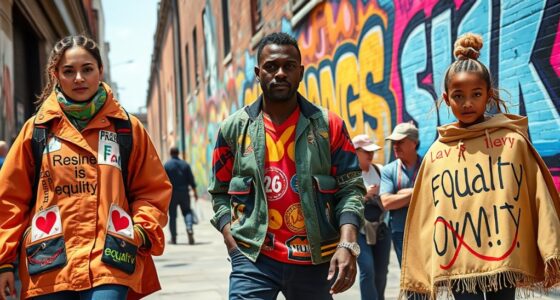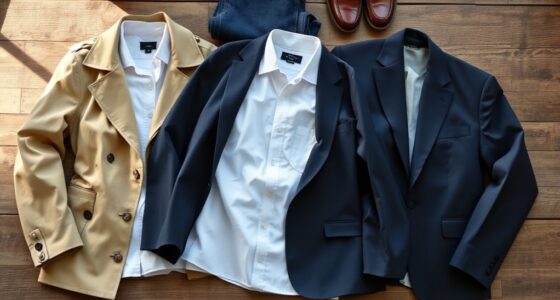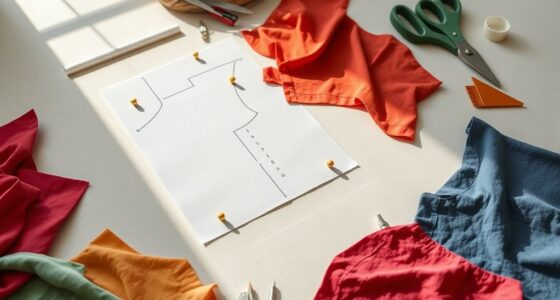To transform old clothes into fresh, personalized looks, start by experimenting with fabric dyeing techniques like tie-dye or dip-dye to add vibrant colors. Enhance your pieces with embroidery, using simple stitches or beads to add texture and detail. Combining dyeing and embroidery allows you to create unique, trendy garments effortlessly. Remember to have fun with different textures, colors, and stitches—there’s so much more to explore for an eco-friendly wardrobe upgrade.
Key Takeaways
- Use fabric dyeing techniques like tie-dye or dip-dye to refresh dull or stained clothing creatively.
- Add embroidery embellishments, such as floral patterns or motifs, to personalize and enhance garments.
- Combine dyeing and embroidery for unique, textured designs that transform old clothes into statement pieces.
- Experiment with colors, stitches, and textures to develop a signature style and make your upcycled items stand out.
- Focus on sustainability and self-expression by turning unused garments into trendy, one-of-a-kind fashion items.

Upcycling is a fun and eco-friendly way to transform old or unused items into something new and valuable. When it comes to old clothes, your creativity can turn worn-out T-shirts or faded jeans into stylish, personalized pieces. One of the easiest ways to give your garments a fresh look is through fabric dyeing. You can experiment with different dyeing techniques, such as tie-dye, dip-dye, or even hand-painting, to create unique patterns and vibrant colors. Fabric dyeing allows you to breathe new life into dull, stained, or outdated clothing, making it look trendy and custom-made. Plus, it’s relatively simple—just pick a dye suitable for your fabric type, follow the instructions, and let your imagination run wild.
Once you’ve added a splash of color, you can enhance your upcycled piece further with embroidery embellishments. Embroidery offers a fantastic way to add texture, detail, and personality to your clothing. Whether you sew simple floral patterns, intricate designs, or fun motifs, embroidery can completely change the vibe of your garment. You don’t need to be a professional seamstress; even basic stitches can produce impressive results. Use colorful threads, beads, or sequins to make your embroidery pop and match your style. Embellishments like patches, appliqués, or fabric paint can also complement your embroidery, giving your upcycled clothes a truly customized look.
Combining fabric dyeing with embroidery embellishments opens a world of creative possibilities. For example, you could dye a plain white shirt in a gradient or marbled pattern, then add embroidery around the collar or hem for a boho-chic style. Alternatively, dye a pair of jeans in a bold hue and embroider floral or geometric designs to make them standout. These techniques not only refresh your wardrobe but also make your clothing more meaningful and one-of-a-kind. Remember, the key is to experiment and enjoy the process. Don’t be afraid to combine different colors, textures, and stitches to develop your signature style.
Frequently Asked Questions
What Are the Best Fabrics for Upcycling Projects?
You should choose natural fabrics like cotton, linen, and wool for upcycling projects because they dye well and hold color vibrantly. These materials also offer interesting textile textures that add depth to your designs. Using fabric dyeing techniques on these fabrics allows you to create unique, personalized looks. Their durability and versatility make them ideal choices for transforming old clothes into stylish new pieces, giving your upcycling projects professional and creative finishes.
How Can I Upcycle Clothes on a Tight Budget?
You can upcycle clothes on a tight budget by getting creative with DIY accessories like fabric patches, embellishments, or custom buttons. Use eco-friendly dyes to refresh faded fabrics and add a unique touch. Thrift stores and your own closet are great resources for affordable materials. With a little effort, you can turn old garments into stylish, personalized pieces without spending much, all while helping the environment.
What Safety Precautions Should I Take When Sewing?
Sewing safely is like steering a ship through calm waters—you need focus and caution. Always handle your needle carefully to prevent pricks, and keep your fingers away from its path. Use a thimble if needed, and work on a stable surface to avoid slips. Pay attention to fabric handling, avoiding snags or tears, and keep your workspace tidy. These precautions help keep you safe while creating your upcycled masterpieces.
Which Tools Are Essential for Beginner Upcyclers?
As a beginner upcycler, you’ll need essential tools like sharp scissors, a sewing machine, and fabric dyeing supplies. Keep your sewing machine well-maintained for smooth sewing, and use fabric dyeing to add color and personality to old clothes. Always have pins, measuring tape, and seam ripper handy. These tools help you create new looks confidently while ensuring safety and quality in your upcycling projects.
How Can I Upcycle Clothes to Suit Different Seasons?
To upcycle clothes for different seasons, start with seasonal fabric swaps—swap lightweight fabrics for warmer ones in winter or breathable materials for summer. Use layering techniques by adding or removing pieces like vests, scarves, or cardigans. You can also dye or embellish fabrics to match seasonal trends. This way, your wardrobe stays fresh, functional, and eco-friendly year-round, making the most of your existing clothes.
Conclusion
Now that you’ve learned these upcycling tips, you’re all set to breathe new life into your old clothes. Remember, it’s often the smallest changes that make the biggest difference. Don’t be afraid to get creative and think outside the box—your wardrobe will thank you! With a little effort, you can turn trash into treasure and truly stand out. So go ahead, roll up your sleeves and show the world that one person’s clutter is another’s couture!









